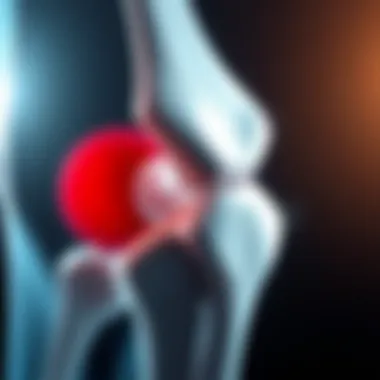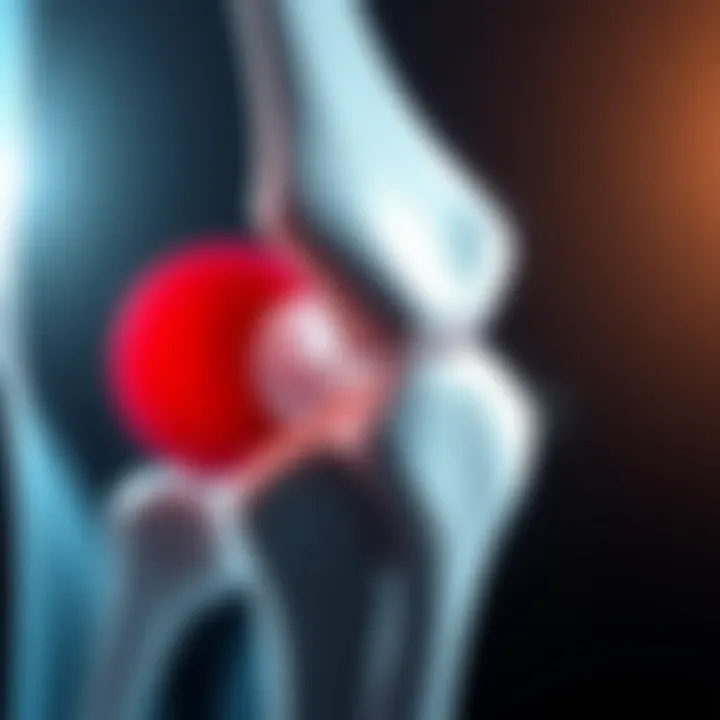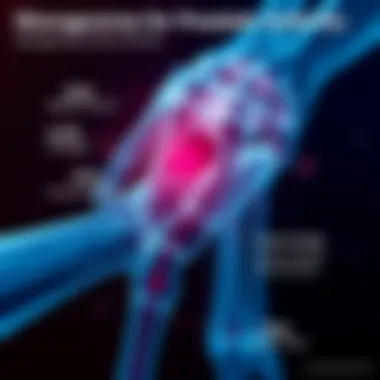Understanding Prosthetic Arthritis: Causes and Treatment


Intro
Prosthetic arthritis is a condition that many may not be familiar with despite its critical relevance in the context of joint replacements. The term might be thrown around in medical circles or whispered among patients recovering from surgery, but what exactly does it entail? At its core, prosthetic arthritis represents the inflammation of the joint capsule that encases an artificial joint. This inflammation may emerge as a troubling complication following joint replacement surgeries, potentially impacting patients in significant ways.
As people age, the need for joint replacements, particularly in hips and knees, tends to increase. Surgeons perform these replacements with the hope of providing relief from chronic pain and restoring mobility. However, as with any surgical procedure, there's always a chance for complications. One such complication is prosthetic arthritis, a rather intricate issue involving biological, mechanical, and patient-specific factors.
This article seeks to peel back the layers surrounding prosthetic arthritis, diving deep into its underlying mechanisms, risk factors, and effective management strategies. Furthermore, we will shine a light on promising research in the field, examining where future treatments are headed. By the end of this exploration, healthcare professionals, as well as patients, will have a clearer picture of this issue that affects countless lives.
Understanding Prosthetic Arthritis
Prosthetic arthritis is more than just a medical term; it is a pivotal concept that sheds light on a complex interplay of biology, surgery, and patient experience. In this section, we focus on defining the term and exploring its historical trajectory, which together lay the groundwork for comprehending its relevance today.
Definition and Scope
Prosthetic arthritis refers specifically to the inflammatory condition that affects the joint capsule surrounding an artificial joint following replacement surgeries. This ailment arises not just from the mechanical failure of the prosthetic device but from an intricate relationship between bodily response and implanted materials. When a joint is replaced, the body does not simply accept the new foreign part; it reacts. The inflammation can manifest variously, causing pain and limiting mobility, effects that are particularly pronounced in those who have undergone knee or hip replacements.
The scope of prosthetic arthritis encompasses a range of symptoms, patient characteristics, and surgical factors. It’s critical for patients and healthcare professionals to understand that the risk of developing prosthetic arthritis hinges on multiple interrelated factors. A deeper understanding thus enables better management strategies, leading to improved patient outcomes. Recognizing the specific challenges posed by this condition cultivates a proactive approach in addressing issues before they escalate.
Historical Context
Examining the historical context of prosthetic arthritis offers insights into how medical practices have evolved and how our knowledge has expanded over time. The journey began in the 1960s when total joint replacements became widespread as medical technology advanced. Early prosthetics were quite rudimentary, often leading to complications, including infections and inflammatory responses due to materials that did not integrate well with human tissue.
In the decades that followed, progress in biomaterials and surgical techniques addressed many initial shortcomings. For example, the introduction of titanium and polyethylene has significantly improved compatibility and longevity of implants, although it has also brought challenges, such as metal ion release and wear debris.
"The history of prosthetic technology reflects a continuous search for harmony between man-made materials and biological tissues."
Current research reflects a sophisticated understanding of these dynamics, showcasing ongoing studies into patient-specific factors that influence the onset of prosthetic arthritis. The emphasis today is on customizing approaches based on comprehensive data, including an individual’s age, activity level, and existing health conditions. Consequently, understanding the historical backdrop enables active contribution to discourse in medical practices and enriches the knowledge base surrounding this crucial aspect of joint replacements.
By grasping the nuances of prosthetic arthritis, stakeholders from medical professionals to patients can better navigate its implications, leading to more informed decisions and enhanced overall joint health.
Mechanisms of Prosthetic Arthritis
Understanding the mechanisms underlying prosthetic arthritis is crucial for healthcare professionals and researchers alike. This topic sheds light on the biological and material responses that can lead to the inflammation of joint capsules post-surgery. By delving into these mechanisms, we can glean insights into not only the pathology of the condition but also potential avenues for innovative treatments. This knowledge isn't just academic; it's vital for enhancing patient care and long-term outcomes.
Pathophysiology
The pathophysiology of prosthetic arthritis centers around the body’s response to foreign materials. When a prosthetic joint is implanted, the immune system may not always recognize it as a benign element. Instead, it can trigger a cascade of inflammatory responses. These responses often originate in the synovial membrane, leading to joint effusion, synovitis, and ultimately chronic inflammation.
In a simplified sense, the process involves various immune cells, including macrophages and lymphocytes, which invade the joint space. They perceive the prosthetic material as a foreign body leading to a defense mechanism firing off. As a result, inflammatory cytokines like interleukin-1 and tumor necrosis factor-alpha are released, inciting further inflammation.
This can create a vicious cycle: increased inflammation leads to joint damage, which in turn further perpetuates the inflammatory response. Over time, this can result in significant discomfort and impaired functionality for the patient. The complexity of the pathophysiological processes highlights the importance of a tailored approach to treatment.
Inflammatory Response
The inflammatory response to a prosthesis is not merely a case of mismatched materials; it's a finely orchestrated series of biological reactions. When the implant is introduced, tissue around the joint reacts to perceived threats, often beyond the initial intent of just integrating with the body. This can lead to a situation where the tolerance to the implant diminishes over time.
There are a few critical aspects to consider regarding this inflammatory response:
- Cytokine Activation: As mentioned earlier, various cytokines play a large role in inflammation. Their levels can become alarmingly high in the presence of wear particles shed from the prosthetic material.
- Joint Capsule Thickness: In individuals with prosthetic arthritis, the joint capsule often becomes thicker due to chronic inflammation. This not only restricts movement but also contributes to increased pain levels.
- Biofilm Formation: In some cases, bacteria can form biofilms on the surface of the prosthesis, complicating the inflammatory response and leading to recurrent infections.
Material Interactions
The interaction between implant materials and biological tissue is another critical component of prosthetic arthritis. Different materials exhibit a variety of biocompatibility profiles, which can significantly influence the outcome of joint replacements. Common materials like titanium and polyethylene often fare well in clinical settings, but some may become problematic over time.
Key considerations in material interactions include:
- Wear Debris: As prosthetic joints experience friction during movement, they can shed minute particles that provoke an immune response. This wear debris can induce inflammation and contribute to the periprosthetic osteolysis, or bone loss around the implant.
- Corrosion: Certain alloys may undergo corrosion when exposed to body fluids, leading to the release of metal ions. This corrosion can cause localized inflammatory reactions, sometimes misconstrued as infection.
- Surface Modifications: Recent advancements in biomaterials focus on surface treatments to enhance integration and lessen adverse reactions. These innovations are essential in mitigating risks associated with material interactions.
Understanding the mechanisms that lead to prosthetic arthritis allows healthcare providers to develop more effective treatment strategies and improve overall patient outcomes. By addressing the biology of inflammation and the role of materials, we can work towards minimizing complications and enhancing joint longevity.
Risk Factors Associated with Prosthetic Arthritis
Understanding the risk factors tied to prosthetic arthritis is crucial for both prevention and management of this condition. Identifying these elements can help patients and healthcare providers navigate the potential pitfalls after joint replacement surgeries. The interplay of patient characteristics, surgical factors, and postoperative complications establishes a pattern that might either predispose individuals to prosthetic arthritis or contribute to its progression.
Patient Characteristics
Patients' individual attributes significantly affect their risk of developing prosthetic arthritis. Factors such as age, sex, body mass index (BMI), and underlying health conditions come into play. For instance, older adults may have a higher risk due to age-related changes in connective tissue and joint flexibility. Furthermore, studies have shown that individuals with certain comorbidities like diabetes or rheumatoid arthritis may face elevated risks, as these conditions can amplify inflammatory responses.


On the other hand, body weight is a double-edged sword; while a healthy weight can aid recovery, excess weight may place additional stress on the prosthetic joint, potentially increasing the likelihood of damage and inflammation.
Surgical Factors
Surgical techniques and the expertise of the medical team also contribute to the risk landscape. Factors such as implant choice, surgical approach, and the surgeon's experience can all affect the short- and long-term outcomes post-surgery. For instance, the selection of materials for the prosthesis plays a deciding role; some implants may provoke an inflammatory reaction due to the body’s response to foreign materials. Similarly, improper alignment or positioning during surgery can lead to uneven stress on the joint, further exacerbating the risk for arthritis down the line.
Postoperative Complications
The aftermath of surgery is crucial, with numerous potential complications that can act as catalysts for prosthetic arthritis. Infections, hemarthrosis, and implant failure are significant concerns that require vigilant monitoring. Infections can stimulate an inflammatory response, while excessive bleeding into the joint space (hemarthrosis) may lead to swelling and pain. Such complications not only complicate the recovery but can also set off a chain reaction, leading to chronic conditions like prosthetic arthritis. Regular follow-ups and vigilance during the early postoperative phase can greatly aid in catching these complications before they evolve into more serious concerns.
Understanding these risk factors allows both patients and medical professionals to tailor management strategies that can minimize the risk of prosthetic arthritis, enhancing overall postoperative outcomes.
Symptoms and Diagnosis
Understanding the symptoms and diagnosis of prosthetic arthritis is crucial for both patients and healthcare providers. Recognizing these signs early can lead to timely intervention, which is essential for sustaining joint function and patient quality of life. This section dives into the clinical symptoms that often indicate complications and examines the role of various diagnostic imaging techniques and laboratory evaluations in confirming these issues.
Clinical Symptoms
Patients suffering from prosthetic arthritis often present various clinical symptoms that can significantly disrupt their daily lives. Common indicators include:
- Pain: Persistent pain around the prosthetic joint, especially during movement or weight-bearing activities, is often the first noticeable symptom. Unlike regular arthritis, pain in prosthetic arthritis can also occur at rest.
- Swelling: Increased swelling around the joint may signal inflammation and should not be overlooked. This swelling can sometimes extend beyond the immediate area of the prosthesis.
- Reduced Range of Motion: As the condition progresses, patients may notice stiffness, making it difficult to fully extend or flex the joint as before.
- Instability: Some may experience a feeling of looseness or instability in the joint, which can be alarming and may affect mobility.
Recognizing these symptoms allows patients to seek medical advice promptly, which can be key to effective management and treatment.
Diagnostic Imaging
X-rays
X-rays are often the first line of imaging when diagnosing prosthetic arthritis. Their primary function is to provide a clear view of the bone structure surrounding the prosthesis. A key characteristic of X-rays is their ability to reveal both alignment and any apparent changes to the joint space.
The simplicity of X-ray imaging makes it a popular choice. It is less time-consuming and comes with lower costs compared to other imaging modalities. However, they do have some limitations; for example, X-rays may not effectively visualize soft tissue changes or subtle bone involvement associated with early stages of prosthetic arthritis.
MRIs
Magnetic resonance imaging (MRI) offers a more detailed look at the soft tissues around the prosthetic joint, making it invaluable in evaluating inflammation and infection. A notable feature of MRIs is their ability to create high-resolution images without using ionizing radiation, which is beneficial in frequent monitoring.
That said, MRIs can be more expensive and time-consuming than X-rays, and certain patients with implants may not be eligible for MRI scans due to the magnetic field. Furthermore, image interpretation can be complex and requires specialized training.
CT Scans
Computed tomography (CT) scans provide a hybrid between X-ray and MRI capabilities. They excel at visualizing both bone and soft tissue, making them useful for assessing surgical complications. A key characteristic of CT scans is their speed; they are often preferred in emergency situations where rapid diagnosis is crucial.
However, CT scans expose patients to more radiation compared to standard X-rays, which limits their use for routine monitoring. Also, while they are excellent for detailed images of bony structures, they can sometimes overlook subtle soft tissue changes, which might be detected on other modalities.
Laboratory Evaluations
Laboratory evaluations complement imaging studies by providing insight into the biological processes at play. Blood tests can reveal inflammation markers such as C-reactive protein (CRP) or erythrocyte sedimentation rate (ESR), which may indicate an inflammatory response associated with prosthetic arthritis. Additionally, specific cultures or synovial fluid analysis can help rule out infection, a common concern in patients with prostheses.
In summary, the combination of clinical symptom recognition, timely imaging, and laboratory evaluations forms a solid foundation for diagnosing prosthetic arthritis. Together, these elements not only assist in immediate treatment planning but also guide future management strategies.
Management and Treatment Options
Managing prosthetic arthritis is crucial for improving patient outcomes and maintaining long-term joint health. The treatment trajectory often hinges on the individual's specific condition and circumstances. Within this section, we will explore two primary avenues: conservative management and surgical interventions. Both routes come with their own sets of advantages and challenges, requiring a tailored approach to meet each patient's unique needs.
Conservative Management
Conservative management serves as a first-line strategy for patients experiencing prosthetic arthritis. It primarily focuses on alleviating symptoms while addressing the underlying causes of the condition. Two key components of this approach are physical therapy and medication.
Physical Therapy
Physical therapy stands out as a vital component in the conservative management of prosthetic arthritis. One of its core aspects includes designing personalized exercise programs that target joint mobility and strength. The key characteristic of physical therapy lies in its non-invasive nature, allowing patients to engage in rehabilitation without undergoing additional surgeries. This makes it an appealing choice for many, as it often leads to improved function and reduced pain.
A unique feature of physical therapy is its emphasis on gradual progression, adapting exercises as the patient improves. Benefits include enhanced range of motion, strengthened muscles around the joint, and overall better post-operative outcomes. However, one should note that physical therapy also has some limitations. Achieving noticeable results can take time and consistent effort, sometimes requiring patients to exercise patience as they work toward recovery. In this article, its value as a conservative management option for prosthetic arthritis cannot be understated.
Medication
Medication also plays a significant role in managing symptoms related to prosthetic arthritis. Typically classified as analgesics or anti-inflammatory agents, drugs such as nonsteroidal anti-inflammatory drugs (NSAIDs) can provide relief from discomfort. A key characteristic of medication management is its accessibility—many patients can achieve significant results with simple medication regimens.


Moreover, the unique feature of medication lies in its quick action. For instance, patients may experience relief from pain in a matter of hours after taking NSAIDs. However, over-reliance on medications may lead to side effects or complications, creating a delicate balance in their use. Despite its advantages, medication should rarely act as a standalone solution—combined with physical therapy, it fosters a more rounded approach to symptom management.
Surgical Interventions
In cases where conservative management falls short, surgical interventions may be necessary. These options include revision surgery and debridement procedures, each with its own rationale and expected outcomes.
Revision Surgery
Revision surgery involves replacing or repairing the existing prosthetic joint. Its main contribution to the overall management of prosthetic arthritis lies in addressing the failures or complications associated with the initial surgery. This type of intervention is often considered when significant pain or loss of function occurs, making it a crucial option for restoring a patient's quality of life.
A defining characteristic of revision surgery is its higher complexity compared to primary joint replacements. This complexity arises from potential complications such as tissue adhesion or bone loss. While the benefits may include prolonged joint longevity and pain relief, patients must also weigh the risks involved, such as longer recovery times or surgical complications. Ultimately, revision surgery serves as a significant aspect of the treatment landscape for prosthetic arthritis.
Debridement Procedures
Debridement procedures focus on removing debris or infected tissue around the prosthetic joint. This kind of intervention is particularly valuable for patients suffering from inflammatory responses associated with prosthetic arthritis. The primary characteristic of debridement is its less invasive nature, aimed at preserving as much joint function as possible while targeting inflammation.
What sets debridement apart is its ability to provide quicker relief for localized symptoms without extensive alteration to the current joint setup. However, while advantages exist, such as a lower risk of complications compared to more invasive surgeries, there’s still the chance of recurrence of the inflammation or pain, necessitating further treatment in some cases. Consequently, it should be viewed as a valuable, yet sometimes temporary, fix in the broader spectrum of management options.
"Each patient's treatment journey is unique, highlighting the importance of personalized management strategies in prosthetic arthritis."
This comprehensive exploration of management and treatment options reveals the multi-faceted approach required to address prosthetic arthritis effectively. Both conservative and surgical avenues offer diverse pathways for enhancing patient well-being, contributing to improved quality of life.
Emerging Research and Future Directions
The investigation into prosthetic arthritis is gaining momentum, with researchers and clinicians alike keen on understanding and improving the outcomes for patients experiencing this complication. This section zeroes in on the pivotal role that innovation plays in addressing the challenges associated with prosthetic arthritis. Focusing on advancements in biomaterials and innovative surgical techniques, the journey through contemporary research reflects a hopeful outlook for the future.
Advancements in Biomaterials
In the realm of prosthetic joints, the choice of materials significantly influences not only the initial success but also the longevity of a joint replacement. Modern biomaterials are designed to interact more favorably with the human body, reducing the risk of inflammatory responses that often lead to prosthetic arthritis. Recent developments include the use of bioactive ceramics and polymeric coatings that promote integration with surrounding bone tissue, minimizing wear and tear.
Moreover, advancements in smart materials are proving to be a game-changer. These materials can respond to environmental stimuli—altering their properties, such as stiffness or porosity, based on the physiological conditions. By enhancing patient compatibility and joint functionality, these developments might lead to a significant decrease in post-surgical complications, including inflammation.
Here are some key advantages of these advancements in biomaterials:
- Reduced Wear Rates: Innovative materials can withstand stress without degrading as quickly as traditional options.
- Biocompatibility: Less likelihood of adverse reactions from the body, leading to fewer cases of prosthetic arthritis.
- Enhanced Integration: Improved bonding to bone can reduce the likelihood of implant loosening.
As research continues, the focus will likely expand, dissecting various approaches to customize biomaterials tailored for individual patients—truly personalized medicine at work.
Innovative Surgical Techniques
The method by which a joint replacement is performed also plays a critical role in the long-term health of the prosthetic joint. Innovative surgical techniques are paving the way for better outcomes, especially in terms of reducing the incidence of prosthetic arthritis. One such technique is minimally invasive surgery (MIS), which employs smaller incisions, leading to reduced trauma on the surrounding tissues.
Key benefits of innovative surgical techniques include:
- Shorter Recovery Times: Patients often find themselves back on their feet faster, which can lead to better surgical outcomes.
- Lower Risk of Infection: Less disruption to the body's natural barriers reduces the likelihood of postoperative complications.
- Enhanced Precision: Advances in robotic-assisted surgery allow for finer control, which can improve the placement of implants and reduce mechanical stress on the joint.
Research indicates that these techniques, combined with advanced imaging technologies for better planning, such as 3D printing of prosthetics tailored to each patient's anatomy, may substantially improve joint health post-surgery.
A deeper comprehension of these advancements not only sketches the outline for future surgical protocols but also keeps the door open for ongoing dialogue between patients and healthcare professionals. As understanding grows, so does the potential for improving patient outcomes and optimizing joint longevity.
"The implications of this research could define the next era of orthopedic surgery, reducing complications and enhancing joint functionality for countless patients."
As we move forward, maintaining an open dialogue between researchers and practitioners will be essential to effective implementation and standardization of these advancements in both materials and surgical procedures.
For further details on biomaterials and surgical innovations in joint replacements, visit sources like Wikipedia or MedlinePlus.
This exploration highlights how emerging research is set to redefine the management of prosthetic arthritis and stands as a testament to human ingenuity and perseverance in the field of medicine.
Long-Term Outcomes
Long-term outcomes in prosthetic arthritis are crucial to understanding how complications from joint replacement surgeries affect patients over time. The significance of this topic cannot be understated, as the longevity of joint implants and the quality of life for patients are often intertwined. Identifying what contributes to positive or negative long-term outcomes can help guide both medical professionals and patients through the post-surgical landscape, ultimately paving the way for better healthcare decisions and patient satisfaction.
Joint Longevity
When it comes to joint longevity, several factors come into play. These are not simply technical specifications of the prosthetic devices but also how patients engage with their rehabilitation and daily activities. Implant durability is an essential aspect, encompassing the materials used, the surgical technique applied, and the biological response from the host body.
To maintain joint longevity, one must consider:


- Material Quality: Biocompatible materials like titanium and cobalt-chromium alloys play a significant role in resisting wear and tear over time. With advancements in biomaterials, newer options are emerging that promise even better longevity.
- Surgical Precision: The meticulousness of the surgical procedure impacts how well the prosthetic integrates into the bone and surrounding tissue. Inaccuracies can lead to premature failure.
- Patient Factors: Patient activities, weight management, and adherence to therapeutic exercises can either prolong or shorten the lifespan of the joint. A robust rehabilitation plan tailored to the individual often makes all the difference.
"Understanding individual patient factors can fundamentally reshape approaches towards joint longevity in prosthetic arthritis."
Quality of Life Considerations
Quality of life (QoL) in patients with prosthetic arthritis often fluctuates throughout the timeline of their treatment and recovery. It is vital to emphasize that a prosthetic joint's clinical success should not solely be measured by the absence of pain or the presence of normal function. Rather, it also encompasses a wider spectrum of emotional and psychological health, social interactions, and overall well-being.
Factors that contribute to the quality of life include:
- Physical Functionality: The ability to perform daily activities without discomfort directly correlates with a positive perception of life.
- Psychosocial Support: Having strong support systems in place—be it from family, friends, or healthcare providers—can significantly influence recovery and overall happiness.
- Patient Education: Equipping patients with knowledge about their condition, treatment options, and self-care can empower them, improving their engagement and satisfaction.
- Follow-Up Care: Continuous assessments and adjustments to treatment plans based on individual progress can directly correlate to improved QoL and successful long-term outcomes.
Patient Education and Awareness
Patient education stands as a cornerstone in managing prosthetic arthritis effectively. When patients are better informed about their conditions, they hold the reins to their treatment and recovery. Education encompasses understanding the nature of prosthetic arthritis, its symptoms, and the strategies available for management. This knowledge empowers individuals to make well-informed decisions about their health, ultimately improving outcomes.
Understanding Risks
The first step in patient education involves an honest discussion about the risks associated with prosthetic arthritis. Individuals often have questions that revolve around factors such as:
- Likelihood of Complications: Understanding that infections, loosening of implants, or persistent pain can occur is crucial for setting realistic expectations.
- Impact of Lifestyle Choices: Weight, activity level, and other health conditions can exacerbate symptoms or increase the chance of complications. Education about healthy habits can be pivotal.
- Medication: Some medications may pose risks of side effects or interactions. Clarity around these will help patients adhere to their treatment plans without surprise.
Informing patients about these risks contributes to informed consent, allowing them to weigh their options carefully based on their personal circumstances.
Empowering Patients
Patient empowerment is about more than just knowledge; it’s about fostering a proactive approach to health. Here are several ways to empower individuals:
- Encouraging Participation in Treatment Decisions: Patients should feel comfortable discussing alternative treatments with healthcare providers. Knowing available options can lead to optimized care.
- Setting Personal Health Goals: Patients can be urged to articulate their own goals, be it managing pain, improving mobility, or returning to sport. These goals can steer the management plan.
- Utilizing Support Resources: Joining support groups, either online or in-person, can provide patients with community and shared experiences, enhancing their coping mechanism.
"Education is the most powerful weapon which you can use to change the world." – Nelson Mandela
Ultimately, addressing both understanding of risks and empowerment equips patients with the tools needed for effective management of prosthetic arthritis. This approach not only enhances their quality of life but also fosters a collaborative relationship with healthcare professionals, ensuring a more holistic approach to treatment.
For further information on patient education, consider visiting CDC.gov and NIH.gov.
Ethical Considerations
The ethical dimensions of prosthetic arthritis are crucial in understanding not only the clinical management of the condition but also the broader implications for patients undergoing joint replacement surgery. These considerations are not merely ancillary; they underpin the principles guiding medical practice and patient care, ensuring that interventions are performed responsibly and with respect for patient autonomy.
Informed Consent
Informed consent stands as a pillar of ethical medical practice, particularly when dealing with complications like prosthetic arthritis that can arise post-surgery. It involves providing patients with all relevant information about the risks, benefits, and potential outcomes associated with their treatment options.
- Understanding Risks: Patients must comprehend the possibility of developing prosthetic arthritis, including the symptoms, the likelihood of occurrence, and the impact on their daily lives. Surgery is inherently risky, and understanding these risks empowers patients to make informed choices about their health.
- Clear Communication: Physicians need to break down complex medical jargon into layman's terms. When discussing informed consent, the goal is to ensure that patients do more than just nod in agreement; they should feel confident in their understanding of what is at stake.
- Ongoing Dialogue: Informed consent is not a one-time conversation. It is a dynamic process that should evolve as new information emerges or as the patient’s condition changes. Continuous dialogue allows for adjustments in treatment plans that align with the patient’s values and preferences.
The engagement of patients in their healthcare decision-making fosters a sense of partnership, vital in navigating the uncertainty that accompanies any surgical intervention.
Resource Allocation
The topic of resource allocation in the context of prosthetic arthritis delves into the ethical dilemmas surrounding healthcare resources and access to treatment. When it comes to managing this condition, particularly in a healthcare environment under financial strain, some critical points arise:
- Equity in Treatment: Not all patients have the same access to care or resources necessary for their rehabilitation. Considerations regarding who receives interventions and how resources are distributed can create disparities in outcomes. Establishing equitable practices ensures that all patients, regardless of socioeconomic status, can access necessary interventions.
- Research and Development: The allocation of research funds for advancements in prosthetic design and treatment methods can also be viewed through an ethical lens. Prioritizing studies that enhance patient outcomes can lead to improved quality of life, yet this must be balanced against other pressing health concerns.
- Cost vs. Benefit: Policymakers and healthcare providers often face tough questions around cost-effectiveness. While newer materials and techniques for treating prosthetic arthritis might be more effective, they often come with a higher price tag. Evaluating whether the potential benefits justify the costs is essential for sustainable healthcare practices.
In considering these factors, healthcare professionals have a responsibility to advocate for fair access and to engage in discussions about how to address these disparities effectively.
By navigating these ethical considerations with care and diligence, medical practitioners can not only enhance patient health outcomes but also contribute positively to the overall integrity of the healthcare system.
Closure
In reviewing the complexities surrounding prosthetic arthritis, it becomes clear that understanding this condition is crucial for both patients and healthcare providers. Prosthetic arthritis does not merely represent a complication; it highlights the intricate interplay between biomechanics, biological responses, and patient-specific factors following joint replacement surgeries.
Summary of Findings
Throughout this article, we've dissected various elements contributing to prosthetic arthritis. Here’s a summary of the key findings:
- Pathophysiological Mechanisms: The inflammation of the joint capsule arises primarily from wear particles and biological reactions, leading to discomfort and implant failure.
- Risk Factors: Individual patient characteristics, surgical skills, and postoperative complications are critical factors that can escalate the risk of developing prosthetic arthritis. These include obesity, age, and previous joint surgeries.
- Symptoms and Diagnosis: Symptoms typically include pain, swelling, and limited range of motion, often requiring advanced imaging techniques like MRIs and CT scans for accurate diagnosis.
- Management and Treatment Options: Strategies range from conservative approaches like physical therapy and medication to more invasive surgical options such as revision surgeries. Each method carries unique benefits and risks that must be weighed carefully by clinicians.
- Emerging Research: Innovations in biomaterials and surgical techniques suggest a promising future direction. Continued research will be vital in improving long-term outcomes for patients.
- Ethical Considerations: The elements of informed consent and resource allocation play significant roles in the decision-making process, emphasizing the need for transparent communication between doctors and patients.
Final Thoughts
As the landscape of orthopedic medicine evolves, so too must our understanding of prosthetic arthritis. It is not enough to merely treat the symptoms. Why this matters cannot be overstated: improving joint health requires a proactive, multifaceted approach involving the latest advancements in research, material science, and surgical expertise. The journey doesn’t stop after surgery; ongoing patient education and awareness of the risks associated with prosthetic arthritis are essential in navigating this condition. As we look ahead, staying informed will be key not only in mitigating the impacts of this inflammatory disorder but also in enhancing the overall quality of life for individuals living with prosthetic joints.
“A stitch in time saves nine.” Investing in education and research today can prevent future complications and lead to better management of prosthetic arthritis down the line.







